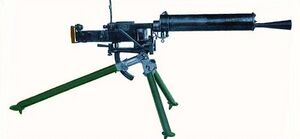Engineering:Fiat–Revelli Modello 1914
| Fiat–Revelli Modello 1914 | |
|---|---|
 | |
| Type | Medium machine gun |
| Place of origin | Italy |
| Service history | |
| In service | 1914–1945 |
| Used by | Italy, Austria-Hungary |
| Wars |
|
| Production history | |
| Designer | Abiel Revelli |
| Manufacturer | Fiat |
| Produced | 1914-1918 |
| No. built | ~47,500 |
| Specifications | |
| Mass | 17 kg gun (without water) + 22.4 kg tripod |
| Length | 1180 mm |
| Barrel length | 654 mm |
| Cartridge | 6.5×52mm Carcano |
| Action | Delayed blowback |
| Rate of fire | 400–500 rounds/min |
| Muzzle velocity | 800 metres per second (2,600 ft/s) |
| Feed system | 50-round or 100-round strip-feed box magazine |
| Sights | Iron |
The Fiat–Revelli Modello 1914 was an Italian water-cooled medium machine gun produced from 1914 to 1918. It was the standard machine-gun of the Italian Army in World War I, and was used in limited numbers into World War II.[2] The ammunition was fed from an awkward large box magazine, which could hold 50 rounds and fired the same 6.5mm round issued for the Carcano rifle. Like many machine guns of that period, it was water cooled and somewhat cumbersome. [3]
Overview
It was very similar to the Maxim in appearance (it had a similar-looking water-cooling jacket and tripod), even though its internal workings were entirely different.
Some sources claim that it had a cartridge-oiling system, but the weapon manual does not mention its presence, and it seems that only a 1930 version briefly incorporated such a system.[4] It was fed from a 50-round or 100-round magazine referred to as a "strip-feed box," divided into ten or twenty compartments, each fed from a rifle clip. This magazine arrangement made it relatively slow to reload, prone to malfunction, and very uncomfortable in its sustained-fire role.
It was chambered for the 6.5×52mm Carcano, which eased logistics (as it was the same cartridge of the Carcano rifle, though it could not be loaded using the 6-round en-bloc clips issued for rifles) but made it somewhat underpowered compared to higher-calibre weapons, weighed 17 kg (37 lb) (the tripod weighed 21.5 kg (47 lb)) and had a firing rate of 400-500 rpm (rounds-per-minute), rather low for this type of machine gun.[5]
One feature was the presence of select-fire, which allowed for the choice between single shot, "normal" fire, and full automatic fire.
It was developed into the Fiat–Revelli Modello 1935.
The machine gun saw some use within armored vehicles, such as the Ansaldo Light Tank Prototype 1931,[6] a precursor to the L3/33 tankette.
References
- ↑ Esdaile, Charles J. (10 October 2018). The Spanish Civil War: A Military History. ISBN 9780429859298. https://books.google.com/books?id=Um5uDwAAQBAJ&pg=PT284.
- ↑ Popenker 2015
- ↑ "MITRAGLIATRICE MODELLO 14 - Quartermaster Section". https://www.quartermastersection.com/italian/infantry-weapons/746/Mod14HMG.
- ↑ Segal 2012
- ↑ Big set N°20 Armi della fanteria (infantry weapons) by John Weeks
- ↑ "Ansaldo Light Tank Prototype 1931 - Tanks Encyclopedia" (in en-US). 2020-02-20. https://tanks-encyclopedia.com/ww2-italy-anslado-light-tank-prototype-1931/.
Sources
- Popenker, Maxim (2015). "Modern Firearms: FIAT-Revelli M1914 and M1914/35 machine gun (Italy)". World Guns. http://modernfirearms.net/en/machineguns/italy-machineguns/fiat-revelli-m1914-m1935-eng/.
- Segal, Robert G. (10 January 2012). "FIAT Revelli Modello 1914". Small Arms Defense Journal 3 (2). http://sadefensejournal.com/wp/?p=823.
External links
- YouTube Animation showing mechanism of Fiat-Revelli machine gun
- YouTube Animation illustrating some additional features of Revelli mechanism
Further reading
 |

